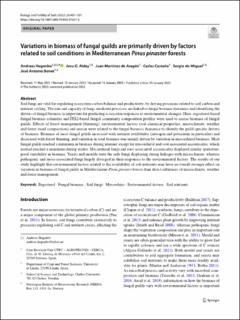| dc.contributor.author | Hagenbo, Andreas | |
| dc.contributor.author | Alday, Josu G. | |
| dc.contributor.author | de Aragón, Juan Martínez | |
| dc.contributor.author | Castaño, Carles | |
| dc.contributor.author | de-Miguel, Sergio | |
| dc.contributor.author | Bonet, José Antonio | |
| dc.date.accessioned | 2022-09-20T18:34:16Z | |
| dc.date.available | 2022-09-20T18:34:16Z | |
| dc.date.created | 2022-05-11T08:47:05Z | |
| dc.date.issued | 2022-01-30 | |
| dc.identifier.citation | Biology and Fertility of Soils. 2022, 58 487-501. | en_US |
| dc.identifier.issn | 0178-2762 | |
| dc.identifier.uri | https://hdl.handle.net/11250/3020022 | |
| dc.description.abstract | Soil fungi are vital for regulating ecosystem carbon balance and productivity, by driving processes related to soil carbon and nutrient cycling. The rate and capacity of fungi-mediated processes are linked to fungal biomass dynamics and identifying the drivers of fungal biomass is important for predicting ecosystem responses to environmental changes. Here, ergosterol-based fungal biomass estimates and ITS2-based fungal community composition profiles were used to assess biomass of fungal guilds. Effects of forest management (thinning), environmental factors (soil chemical properties, microclimate, weather and forest stand composition) and season were related to the fungal biomass dynamics to identify the guild-specific drivers of biomass. Biomass of most fungal guilds increased with nutrient availability (nitrogen and potassium in particular) and decreased with forest thinning, and variation in total biomass was mainly driven by variation in mycorrhizal biomass. Most fungal guilds reached a minimum in biomass during summer except for mycorrhizal and root-associated ascomycetes, which instead reached a minimum during winter. Mycorrhizal fungi and root-associated ascomycetes displayed similar spatiotemporal variability in biomass. Yeasts and moulds were the only fungi displaying strong linkages with microclimate, whereas pathogenic and moss-associated fungi largely diverged in their responses to the environmental factors. The results of our study highlight that environmental factors related to the availability of soil nutrients may have an overall stronger effect on variation in biomass of fungal guilds in Mediterranean Pinus pinaster forests than direct influences of microclimate, weather and forest management. | en_US |
| dc.language.iso | eng | en_US |
| dc.publisher | Springer Nature | en_US |
| dc.rights | Navngivelse 4.0 Internasjonal | * |
| dc.rights.uri | http://creativecommons.org/licenses/by/4.0/deed.no | * |
| dc.title | Variations in biomass of fungal guilds are primarily driven by factors related to soil conditions in Mediterranean Pinus pinaster forests | en_US |
| dc.title.alternative | Variations in biomass of fungal guilds are primarily driven by factors related to soil conditions in Mediterranean Pinus pinaster forests | en_US |
| dc.type | Peer reviewed | en_US |
| dc.type | Journal article | en_US |
| dc.description.version | publishedVersion | en_US |
| dc.rights.holder | © The Author(s) 2022 | en_US |
| dc.source.pagenumber | 487-501 | en_US |
| dc.source.volume | 58 | en_US |
| dc.source.journal | Biology and Fertility of Soils | en_US |
| dc.identifier.doi | 10.1007/s00374-022-01621-4 | |
| dc.identifier.cristin | 2023282 | |
| cristin.ispublished | true | |
| cristin.fulltext | original | |
| cristin.qualitycode | 1 | |

